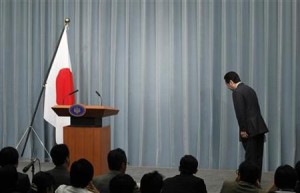 Japan’s fragile post-disaster political truce unraveled on Thursday as the head of the main opposition party called on unpopular Prime Minister Naoto Kan to quit over his handling of the country’s natural calamities and a nuclear crisis.
Japan’s fragile post-disaster political truce unraveled on Thursday as the head of the main opposition party called on unpopular Prime Minister Naoto Kan to quit over his handling of the country’s natural calamities and a nuclear crisis.
At the stricken Fukushima Daiichi plant in the northeast of the country, engineers were struggling to find a new way to cool one of the six crippled reactors and Japan’s Nuclear and Industrial Safety Agency said it was now “highly likely” there was a hole in the suppression unit of the reactor.
Kan, whose public support stands at about 30 percent, had sought a grand coalition to help the country recover from its worst ever natural disaster and enact bills to pay for the country’s biggest reconstruction project since World War Two.
Kan’s Democratic Party controls parliament’s lower house but needs opposition help to pass bills because it lacks a majority in the upper chamber, which can block legislation.
But the head of the main opposition Liberal Democratic Party (LDP) — who last week ruled out joining hands — on Thursday pressured Kan to go.
“The time has come for (the prime minister) to decide whether he stays or goes,” Kyodo news agency quoted Sadakazu Tanigaki as telling a news conference.
Tanigaki’s comment reflects the view of many in his conservative party that Kan must step down as a precondition for any coalition as well as a hope that criticism of Kan within his own Democratic Party will gather steam after party powerbroker Ichiro Ozawa blasted the premier over his crisis management.
Upper House speaker Takeo Nishioka, a well-known Kan critic from the Democrats, also urged Kan to resign, Kyodo said.
Kan, however, who took office as Japan’s fifth leader since 2006 last June, is not likely to step down readily, while opposition parties could come under fire if they try to take disaster budgets hostage in a political battle, analysts said.
“Kan will probably ignore this,” said Koichi Nakano, a Sophia University professor. “If they thought of the national interests, would they (Kan’s critics) do this now?”
STILL NO CLOSER TO SOLVING NUCLEAR CRISIS
Five weeks ago a massive earthquake and tsunami left nearly 28,000 dead or missing, devastated a broad swathe of northeast Japan and damaged the Fukushima nuclear plant. There has been no sign of a resolution of the atomic crisis.
The nuclear safety agency said a new plan for cooling one of six reactors at the plant, 240 km (150 miles) northeast of Tokyo, may be needed due to the large volume of highly radioactive water on site, and tests would be done to determine if damaged spent fuel rods were emitting radiation.
“It may be difficult to completely remove the contaminated water and so allow work to proceed (in restoring power to the cooling pumps). We may need to think of other options,” said Hidehiko Nishiyama, a deputy director-general of Japan’s Nuclear Industry and Safety Authority.
Nishiyama said there was 20,000 tones of contaminated water in the basement and a tunnel under reactor No. 2.
“What makes the No.2 unit decisively different from No.1 and No.3 units are that it is highly likely that there is a hole on the (No.2 unit’s) suppression chamber after as an explosion was heard. It would be an accurate speculation that there is leakage.”
Engineers are also concerned that some spent fuel rods were damaged by the March 11 earthquake and tsunami and could be emitting high levels of radiation.
Japan’s nuclear crisis has been rated on par with the world’s worst nuclear crisis at Chernobyl in 1986, although the total amount of radiation released is only a fraction of that when the nuclear plant in Ukraine exploded.
Japan has expanded a 20-km (12-mile) evacuation zone around the plant because of high accumulated radiation. No radiation-linked deaths have been reported and only 21 plant workers have been affected by minor radiation sickness.
A series of strong aftershocks this week has rattled eastern Japan, slowing the recovery effort at the plant due to temporary evacuations of workers and power outages.
The total cost of the damage has been estimated at $300 billion, making it the world’s most costly natural disaster.
Makoto Iokibe, head of a newly created government panel tasked to come up with a revival plan, floated the idea of setting up a special reconstruction tax in addition to bond sales and donations as ways to fund the bill.
“Given the potential scale of the cost, it might need to be shouldered by the entire Japanese people. That’s why I mentioned (the special tax). But nothing concrete has been decided,” Iokibe told a news conference after the panel’s first meeting.
Business confidence plunged to a record low in April, according to a Reuters survey, and the International Monetary Fund (IMF) has warned the risk to the world’s third largest economy is firmly on the downside.
The IMF cut Japan’s economic growth forecast to 1.4 percent this year from 1.6 percent, projected three months ago, and the Bank of Japan is expected to cut its January growth forecast of 1.6 percent when it issues its twice-yearly outlook on April 28. ($1 = 83.890 yen)
TOKYO (Reuters) – By Linda Sieg and Mayumi Negishi
(Additional reporting by Mayumi Negishi, Yoko Nishikawa, Kiyoshi Takenaka and Kazunori Takada in Tokyo, Alexei Anischuk in Sanya, China and Leika Kihara in Washington; Writing by Linda Sieg and David Chance; Editing by Robert Birsel and Sanjeev Miglani)





